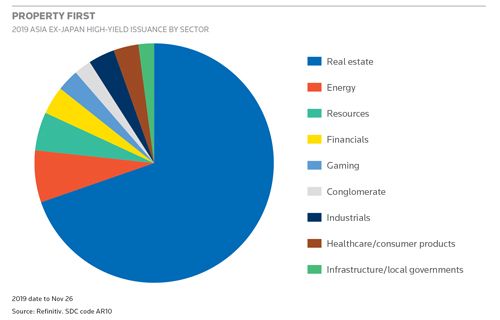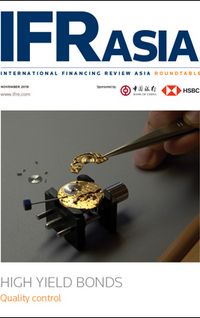
IFR Asia: Okay. We’ve had plenty of new issuers this year. Adrian, have the Chinese property companies’ capital structures changed, and what does that mean for recovery prospects for unsecured bondholders?
Adrian Cheng, Fitch: Yes, I think in general this year, especially for those that could access the market, the senior unsecured portion of the capital structure has definitely increased and, therefore, we have seen some smaller homebuilders with better recovery prospects. Therefore, when we assign them senior unsecured ratings a lot of them have actually moved up as a result. But I think, on the other hand, from a corporate perspective, they’re always going to balance a few things.
Firstly, cost. They’re not going to access the offshore market if the cost is wrong. But the other things I think they need to consider are their debt maturity profile and also balance how their cashflow matches the liabilities – basically asset-liability matching. For me, my personal view is that there’s a misconception that the assets that homebuilders have are long-term assets when, in fact, I think a lot of property developers intend to sell assets within one year or maybe a maximum of two years.
So, maybe it makes sense for them to have a lower tenor in the capital structure than other corporates which may want to term out their loans. So, I think if the cost is not an issue, then they would prefer to access the senior unsecured market, but they’ll have to balance the maturity profile.
Zhang Hongbao, BOC: In June 2019, the National Development and Reform Commission issued a circular on the registration requirements for local state-owned enterprises to apply for foreign debt issuance. It emphasises the importance of submitting real application materials for filing and registration of issuing foreign debt. Local state-owned enterprises need to be in business for not less than three years for filing and registration of issuing foreign debt. The circular emphasised that local governments shall not provide guarantees for local state-owned enterprises to issue foreign debts, and that local state-owned enterprises that assume the financing functions of local governments shall only issue foreign debts to repay medium and long-term foreign debts that mature in the next year. As a result, issuance of LGFVs is expected to decline in 2020.
IFR Asia: We’ve talked about the property sector being, on the whole, easier to understand for investors, but looking at Asia and high-yield as a whole, Monica, do you think there’s a need for issuers to be more transparent? Are there any weaknesses?
Monica Hsiao, Triada: Yes, we mentioned earlier about reporting and transparency. I believe we should, as an investor base, start pushing for more formalised reporting requirements in the bond covenants. I feel that that would help a lot to open the markets, even for bank syndicates to print more bonds if we had greater assurance of reliable periodic reportings.
On the covenant side, I would say I have seen FCCRs (fixed-charge coverage ratios) start to decline. I’ve been in this market since the end of 2009 and FCCR used to be around 2.5x–3.0x and I think this was thought of as appropriate in order to pay the risk that we are taking here for structural subordination. However, now it’s trending down towards 2x, and I think this is something that we have to be careful about, because this trend, obviously, is loosening the amount of ratio debt that a company can incur.
For our bonds, we have only incurrence and not maintenance test, and then within that we should be careful of the definition of Ebitda over fixed-charge. Ebitda, especially for Chinese property, needs to be examined on a case-by-case basis, whether it’s appropriate to allow for Ebitda to include revaluation gains that are not yet realised, because that, obviously, can cause an inflation of Ebitda for FCCR calculation purposes.
And then on the denominator side, the fixed charges side, we also have to be careful because we’ve seen more and more cases of issuers – especially those in weaker Chinese provinces – that have granted a lot of third-party guarantees, and the interest charge of the third-party guaranteed debt is not included in the definition and the calculation of the fixed charge. Once upon a time, you could argue that that’s okay because it doesn’t come due until you’re called on under the guarantee, but now that conditions are worsening, you may have a higher risk of the guarantees being called upon.
Daniel Kim, HSBC: I totally agree with Monica’s comments earlier. Obviously, we had that incidence in Indonesia where a private company did default. I think the challenge we face now with a lot of big companies, and this is predominantly more in South-East Asia, is that we do see a lot of private-sector unlisted companies wanting to come to the debt markets. Sometimes when we meet investors, the first feedback is, “I have no interest because it’s not listed,” and I think it has to do with a lot of events that have happened in the past.

So, I do agree, for us to help improve the market and increase the business from new jurisdictions, let’s say South-East Asia, we need some more stringent requirements for some of these unlisted companies to disclose on a timely basis to investors.
Adrian Cheng, Fitch: I think one thing that’s apparent in the property industry in the past few years is the increased use of joint ventures and associates in the projects. Now, luckily, most of these issuers have been quite open to us and been quite transparent to us in terms of their data, on things like cash and debt at the joint venture levels, but I think it still varies a little bit. Some of them, strangely enough, especially the larger ones, tend to be less willing to give us that information, but that’s perhaps because they have so many JVs. But I think we would like more transparency in those JV projects.
IFR Asia: Okay, so that’s transparency at the issuers. Hongbao, does there need to be more transparency or higher standards in bookbuilding across Asia?
Zhang Hongbao, BOC: I think that’s a question a lot of investors want to ask. To be honest, as an underwriter, it’s really tricky for us to criticise the misconduct we saw during some bookbuilding process. Also, we would like to see the issuer maintain regular communications with the market, and contribute to make the bookbuilding pricing process more transparent by publishing book updates and statistics.
Although there are no legal regulations to restrain inappropriate behaviours such as rebates, I think at the end of the day, investors would notice if an issuer or an underwriter is doing the right thing. I still believe we are in a society in which mutual trust and honesty are valuable assets. Some participants might think they could get deals and orders by cheating once or twice, but it won’t last long. The market would be able to tell what they are doing and abandon them next time. Meanwhile as a market leader, Bank of China is a firm believer of good market practices and we are sticking to do what is right in every deal.
Monica Hsiao, Triada: It has been very frustrating for those of us on the investor side because there is a real lack of transparency in bookbuilding. There has been a slight improvement, which is that, finally, there’s been more disclosure of the overall JLM interest in the book, so that’s a bit of progress. But the market is confusing now where there are so many “sole-order books” or “X-order books” that it is harder to gauge the quality or actuality of true demand for bonds.
I’m not even going to comment on the whole issue of fee rebates, but just with the bookbuilding process alone, it still becomes very relationship-driven as to whether or not specific investors have better access to detailed information about the book quality. I really yearn for the old days where it was very simple. You just put it in through your orders to the main lead underwriters in one pot and that’s it, and everybody’s on a more equal footing.
I’ve also noticed in the last two years that in a number of deals we have heard from the lead banks, “Oh, we helped with the bookbuilding but allocations are actually out of our hands because the issuer has taken control.” That makes it also difficult even for the underwriters because the issuer will handpick and decide on their own how to allocate, which I think also defeats the process of hiring the banks to manage it as it starts looking more like a club deal rather than a public deal.

Daniel Kim, HSBC: Like, there’s been a lot of technology that has been introduced to the execution of bonds within the last 12-24 months. The banks are definitely working on trying to improve it. Monica mentioned the JLM order and having that as kind of a separate line item in the book updates. That’s a product of the banks working with ICMA, and they are definitely working with them on trying to fix a lot of the other issues that we see in the market. So, hopefully, going forward, we’ll see that a lot of this technology will not be there anymore or at least be better for the investor community.
IFR Asia: Yes, we get the JLM orders throughout bookbuilding. We don’t really get them at the end to see who actually bought it. Leading on from that is what’s the state of liquidity in the Asian high-yield bond market?
Monica Hsiao, Triada: Trading liquidity definitely is better than last year. Last year’s Asian high-yield credit market felt like a “death by a thousand cuts” type of environment. Trading liquidity in Asia, as with all credit markets, frankly, can always come and go, but this year, overall, has been relatively healthy. That said, I think liquidity provision by dealers is very much on a bond-by-bond basis, and there’s always a cyclical nature to this. As we get into year-end, trading liquidity always starts to fall off.
One thing that I would note, though, is that as much as we have so many counterparties now in this market, the vast majority of the counterparties exist to create primary markets and not service secondary markets. In the old days, it used to be that those who came out with the primary issuance should have kind of a moral duty to service their bonds that they issued, to provide some kind of secondary trading liquidity. It may be crap liquidity, but they would stand to show some bid-ask market.
Today, we don’t have that anymore, so it makes it harder for investors to find an exit at times. And one point that I hope all the market participants start thinking of is how to maintain long-term, healthy growth for our Asia credit markets. As much as we keep growing in supply (and the JACI is crossing a trillion USD, rivalling the size of the US high-yield market) we need to also grow in sophistication and have a long-term vision. The banks would serve their long-term interests by providing more trading liquidity for the bonds that they are pushing out.
IFR Asia: Thank you. Going back to NDRC approvals for a bit, we’ve talked about how certain issuers are being granted approvals only if they’re refinancing certain kinds of debt. Hongbao, do you see NDRC approvals slowing down for any particular sectors or kinds of issuers, like low-rated ones?
Zhang Hongbao, BOC: For the LGFV issuers, it will be a challenge to get NDRC approval. Meanwhile the other sectors may benefit from this situation by getting their quotas more easily. Some high-quality companies under the control of the central government may get more quotas as well. Overall I think there’s a fine balance, but definitely a slowdown for low-rated LGFVs.
Adrian Cheng, Fitch: Just to add to this, we speak to developers and when this NDRC new rule came out, it was quite obvious to us what it meant. It meant they had to strictly refinance offshore debt that comes due in one year, but when we actually speak to issuers recently, it seems there’s a little bit of confusion of how this exactly applies to them.
Now, most of them assume that it’s what I’ve just described, but some developers have also told us that there may be some flexibility in those rules. I’m not too sure about that, or whether NDRC’s going to apply it strictly to property developers. I think we’ll have to see how it goes next year when the new approvals come in place.
Now, to emphasise the existing approvals that the developers have right now, they’re not under the new rules so they can still continue to refinance onshore debt with that. I think they can also refer to what’s happening in the LGFVs, but that’s why it’s a little bit puzzling to me why there’s some confusion among the developers.
IFR Asia: Yes, we’ve been hearing for about two years that NDRC approvals were going to slow down for all kinds of sectors, but it still seems to be continuing at full speed.
Zhang Hongbao, BOC: The overall impact is relatively limited, because most of the Asia high-yield issuers have low exposure to the US market. We think the trade conflict is having more impact on affecting the market sentiment, which has been changing with the negotiation process between the two powers. Since August, the secondary market has been volatile. When there was negative news about the trade war, the spread widened and risk appetite reduced.
Recently, with the conclusion of the preliminary agreement between the two countries, we have seen an improvement in market sentiment, and the spread has also tightened.
IFR Asia: So, that’s covered a lot of topics. Are there any particular reasons for caution in the Asian high-yield market going ahead?
Daniel Kim, HSBC: I guess from my side, there’s obviously a lot of global macro events that the market can use as a reason to have an inflection point. I think investors such as Monica have had a very good year this year, and they probably are just wondering when that inflection point is coming. So, I guess for the high-yield markets that would probably be the worry, whether Brexit, Syria, North Korea, or Trump would cause the markets to start selling off.
Obviously, we’ve had a fantastic year. For our business, we would like this to continue to next year, as well, and onwards, but markets are never one direction, and there’s always going to be a correction point.
Monica Hsiao, Triada: Yes. For us, we are long-short credit hedge fund manager and we are very much event-focused. In times of rough markets like last year, we still stayed positive, not because we’re always going for it, but because it really comes down to name-picking. Whether it’s an easy market or not for bonds as an asset class, it doesn’t affect our investment process that continues to focus on fundamental research and diligence at the company level.
What I’m worried about, specific to Asia credit markets today, is any policy misstep by China. We were very worried over the first half last year when they were overzealous in deleveraging, and I think that China policymakers were very smart and very quick to correct, and we have seen so far that they have been good at making the adjustments as and when needed. I believe that what is the advantage about a centralised command economy is that they can mobilise and decide very quickly.
So, I do have a lot of optimism in China’s ability to adjust and control policies where they see fit. Deleveraging, as an overall theme will continue. It’s just that they are much smarter at doing it in a way that they can maintain financial stability. As an example, we saw that PBoC didn’t go as aggressively as people thought about cutting the loan prime rate and I believe that part of it is because they know that monetary easing is only one part of the equation. They have had a surgical approach to apply different tools of easing to maintain liquidity between banks and interbank rates. That’s very important.
And then you can see that they’ve maintained relative stability in CNH, which is also important. I believe that China’s goal is to accelerate the internationalisation of the renminbi and capital inflows, and they know that requires a stable currency market. All of that presents quite a favourable backdrop for Asian credit markets which will benefit from a stable US dollar, a low US rates environment, and benign EM currencies.
However, the theme for us continues to be about credit differentiation and name selections, going into next year. Defaults are still expected to grow but it is actually quite amazing that this year to date, we have an under 2% default rate. Even onshore the default rate is actually starting to moderate, on a monthly basis. But defaults in absolute terms will keep going up next year.
We just had the first SOE onshore bond default in October. We haven’t had an onshore default in LGFVs yet, and I believe there’s a good reason for that, because the maintenance of confidence in LGFV markets is necessary to implement some reforms and fund infrastructure spending onshore. In 2020, Asian credit markets should continue to have a benign backdrop and we still expect to have continued demand for yield and see bond fund inflows. Next year, Asian credit markets should compare better to Asian equity markets because China easing isn’t targeting to inflate growth, it’s aiming to maintain financial stability and consolidate the banking system, which will be very positive for the long-term health of Asian credit markets. For us, as hedge fund manager, it all comes down to bottom-up analysis to make credit selections.
Adrian Cheng, Fitch: Yes, I think, in terms of the Chinese property sector, Fitch has actually been negative on this sector since the end of last year, but, ironically, we’ve actually upgraded more companies this year than last year. That intuitively sounds strange, but, when you think about it, the slowdown in the market actually presents a good deleveraging opportunity for these companies. If they are not chasing growth, all they have to do is to sell the properties and get the cash, and as long as they maintain a good land bank, they can actually deleverage pretty quickly.
So, I think for such companies, I’m moderately optimistic about their ability to do so. I think the risks are mainly for those small ones which have difficulty getting liquidity, and are having difficulty to sell, so our focus is going to be on those. Secondly, we see some very small players trying to come to the market this year. I think you need to be very careful what the actual use of proceeds are, what they are using the money for, because, quite often, it could be used for something which does not benefit the creditors. I can’t be more specific here.
Zhang Hongbao, BOC: Pay close attention to the fluctuation of the renminbi exchange rate and the currency mismatch, because, generally, US dollars made up 30% of funding for China real estate companies. The uncertainty around the trade conflict also creates idiosyncratic risk, because high-yield bonds are more sensitive to risk factors.
Geopolitical risk is also a major factor, such as the deterioration of Japan-Korea relations, Brexit, and the elections in various countries.
Be wary of the default risk. The safety of LGFVs is generally still high. Since the third quarter, the market has expected credit policy to be more accommodative, but it has not been seen. Even after PBoC announced the RRR cut in early September, the bond market did not rise. Instead, the monetary easing was less than expected and hence, the market has been volatile. Going forward, monetary policy is expected to be prudent, and the government will focus more on reducing interest rates for the corporate sector.
When looking at the operating performance of bond issuers, their profits have not improved, the financing environment has been tough, and hence, many have begun to accelerate the return of cash. Under such circumstances, the pressure on repaying bonds in Q4 is high for issuers. Default risks may rise. Compared with others, the possibility of a LGFV going into default is low, and this is a consensus among investors.
Considering the uncertainty and high valuations recently, it is recommended to control the duration within three years and avoid LGFVs in weaker regions.
IFR Asia: Okay, so just to wrap up, I’d like to ask all of our panellists what are the opportunities for Asian high-yield bond market development going forward. I guess you’re all going to have a slightly different perspective.
Daniel Kim, HSBC: From my side, I think we’re definitely going to see more non-property China high-yield names come out. We’re also starting to see issuers from jurisdictions where it’s been quiet in the past, namely South-East Asia. And then I think we’ll start to see more M&A-related or sponsor-backed transactions. We have only had a handful of anything sponsor-backed, but I think, going forward, that’s definitely a market in the high-yield space that will continue to grow.
Adrian Cheng, Fitch: I completely agree, which means my workload’s going to get easier next year, so that’s good.
IFR Asia: Hongbao, what opportunities do you see for the market to develop going forward?
Zhang Hongbao, BOC: I think there is still a lot of room to get better performance, and we can see that onshore market liquidity has really improved this year, and the global economy and the global liquidity are also in a good situation. So, we can still imagine a very good performance from the bond market, especially the high-yield bond market.
IFR Asia: Monica, what are your thoughts?
Monica Hsiao, Triada: We will continue to do what we do, which is to focus on building positions in secondary trading markets. We are always looking at primaries too, of course, but secondary trading on event catalysts has been our bread and butter because of headlines that trigger price dislocations. I think there’s going to be a wealth of investment opportunities next year. We are busy every week with headlines as it is. So, that will continue because I believe market volatility will remain high.
Separately, one of the developments that we will be watching over the next five years is a convergence between offshore and onshore bond markets. Certainly, now you see that with credit events and catalyst plays, people like us have to watch what’s going on in the onshore market. At present the onshore corporate credit market is still not developed enough with the lack of trading liquidity and high transaction costs.
Although the number is slowly growing, many investors have not yet applied to use Bond Connect. However, the trend eventually has to be that as that market becomes more liberalised, hopefully more market-oriented, the two markets will converge, but it will take time.
IFR Asia: Ladies and gentlemen, thank you very much for your time.
To see the digital version of this roundtable, please click here
To purchase printed copies or a PDF of this report, please email gloria.balbastro@refinitiv.com


